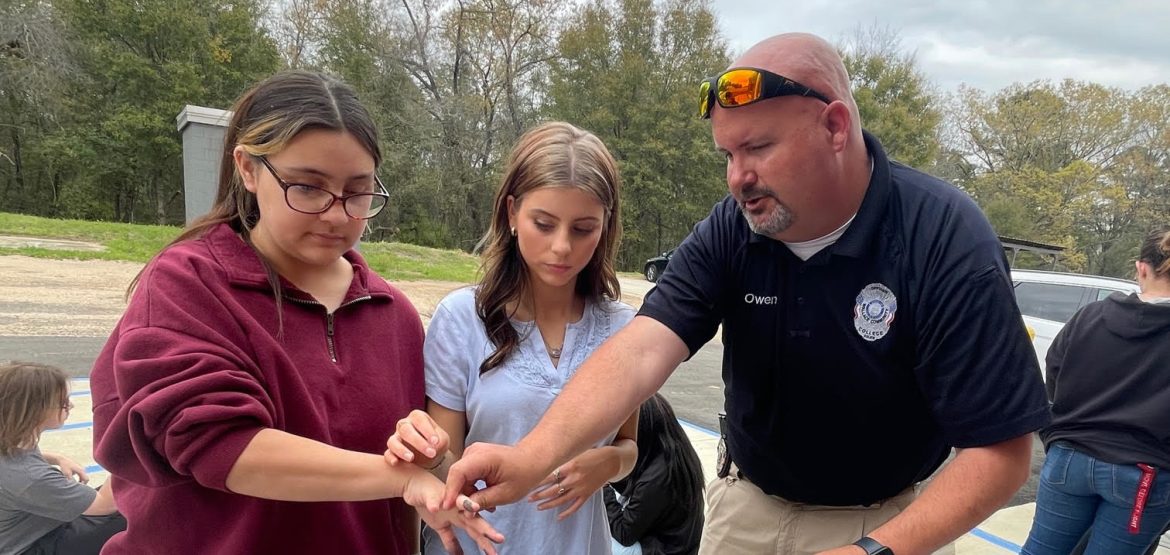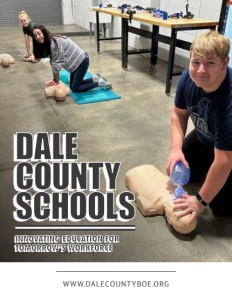Dale County Schools
Innovating Education for Tomorrow’s Workforce
Bridging academic excellence with real-world readiness and a dynamic curriculum focus
Dale County Schools, nestled in the heart of Alabama, stands out as a great example of educational excellence and innovation, bridging academic achievement with real-world readiness. Under the stewardship of Ben Baker, Superintendent, Lisa Welch, Career Tech Director, and other able leaders, this district has carved a niche for itself, seamlessly integrating traditional learning with career and technical education (CTE) to prepare students for the demands of the modern workforce.
Baker eloquently captures the essence of the district’s mission, emphasizing the comprehensive development of students beyond mere academic success. “Our main objective is to create value for our students in every possible way—academically, socially, emotionally, and physically,” he asserts. This holistic approach is about equipping students with knowledge and nurturing them to become well-rounded individuals capable of navigating the complexities of today’s world.
Dale County Schools’ reputation for excellence is not unwarranted. As Baker proudly points out, “We’ve been recognized on both the state and federal levels, home to national Blue-Ribbon schools and distinguished as one of the top 100 schools in the United States.” These accolades reflect high test scores and the district’s success in overcoming challenges, such as increased student poverty rates. Baker sees these obstacles not as excuses but as opportunities to make a real difference. “We aim to create value for every child, regardless of background. This means addressing their academic, emotional, and even basic needs, ensuring they have the support necessary to succeed,” he elaborates.
Beyond the Classroom
 As education rapidly evolves to meet the demands of the 21st century, Dale County Schools are at the forefront, embracing innovative approaches to learning that prepare students for academic and real-world success. Baker details the district’s commitment to enhancing educational experiences by integrating STEAM (Science, Technology, Engineering, Arts, and Mathematics) initiatives starting in early grades.
As education rapidly evolves to meet the demands of the 21st century, Dale County Schools are at the forefront, embracing innovative approaches to learning that prepare students for academic and real-world success. Baker details the district’s commitment to enhancing educational experiences by integrating STEAM (Science, Technology, Engineering, Arts, and Mathematics) initiatives starting in early grades.
“We’ve made significant advancements in STEAM, transforming a classroom into a high-tech lab at Southdale Middle School,” he reveals. This transformation is more than an upgrade in facilities—it represents a shift towards a learning model that emphasizes practical application over theoretical knowledge alone. Baker adds, “Education in the United States must transition to teaching theory and emphasizing application, especially starting from the lower grades.”
Taking a step further into practical education, Baker shares an innovative program at George W. Long High School—a fully operational student-run bank. “This is part of our workforce development initiative, providing students with the opportunity to apply what they’ve learned in real-world scenarios,” he explains. The bank, operated in partnership with All In Credit Union, serves the dual purpose of teaching students valuable financial and social skills while addressing community needs. “This project is a perfect example of how our school and community partners collaborate for mutual benefit,” he notes, underscoring the symbiotic relationship between educational institutions and the wider community.
Lisa Welch, speaking from her vantage point as Career Tech Director, outlines the strategic partnerships that Dale County Schools have forged with post-secondary educational institutions, such as Wallace Community College, Enterprise State Community College, and the Alabama Aviation College. “These partnerships enable our students to engage in dual enrollment, gaining college credits while still in high school,” Welch states. The district’s connection with the aviation industry is particularly noteworthy, facilitated by its proximity to Fort Novosel, the largest aviation training installation globally. “Our students have the unique opportunity to delve into aviation mechanics and avionics, paving the way for a career in this high-demand field,” she highlights.
Through these initiatives, Dale County Schools demonstrate a profound understanding of the changing educational landscape, adopting an approach that equally values academic achievement and practical skills development. By fostering early engagement in STEAM and facilitating real-world experiences through programs like the student-run bank and partnerships with the aviation sector, the district prepares its students for success in both higher education and the workforce.
Enriching Lives Through Workforce Development and the Arts
Dale County Schools not only focus on traditional academics and technical skills but also emphasize the importance of integrating arts and real-world workforce experiences into their curriculum. Welch elaborates on the district’s dynamic approach to workforce development, illustrating the depth of their engagement with the local economy and community.
“We’re deeply involved in our regional workforce development councils and collaborate closely with local businesses and industry partners,” she states. This collaboration extends beyond mere advisories, with a robust work-based learning program that saw 103 students contribute approximately $250,000 in wages to the local economy. “Our work-based learning coordinators play a pivotal role in sustaining these vital connections, ensuring our students gain invaluable real-world experience,” Welch adds. The initiative’s success is further evidenced by the district’s inaugural job shadow event, which is expected to broaden students’ exposure to various industries.
On the arts front, Baker has taken pride in the district’s substantial advancements since he assumed office. “We reintroduced music and art classes at the elementary level and revitalized band programs, now featured in two of our three schools,” he explains. The collaboration with Ozark City Schools has also birthed a substantial theater program, highlighted by the annual production that engages the community and provides students a platform to showcase their talents. “Participation in theater and music not only enhances students’ resumes but also fosters essential skills like discipline and teamwork,” Baker notes, emphasizing the value of the arts in education.
Baker proudly reflects on the district’s accomplishments in sports, including state championships in baseball, softball, and volleyball. “Our success in athletics is a collective effort, supported by talented students, dedicated coaches, and a community that values all aspects of student development,” he says. This tradition of excellence in sports, alongside achievements in the arts and workforce development, is a nod toward Dale County Schools’ efforts to cultivate diverse talents and interests, preparing students for success beyond the classroom.

Advancing Infrastructure and Health Sciences
Technological advancements and health sciences are pivotal to today’s economy, and Dale County Schools are keeping pace and setting benchmarks for comprehensive educational environments. Baker outlines the district’s proactive approach to ensuring safety and well-being by installing sophisticated monitoring systems.
“We’ve added advanced camera and monitoring systems capable of detecting potential issues, from vaping to harassment,” he states, emphasizing the dual focus on curbing vaping and enhancing student safety. Moreover, he mentions substantial investments in physical education facilities, including constructing three new gymnasiums. “These gymnasiums are not just buildings; they are a commitment to our students’ physical health, providing them with opportunities to stay active regardless of the weather,” he explains. The climate-controlled spaces represent a significant step towards addressing health and obesity concerns, especially in the post-pandemic era.
The expansion of Bridge Academy, supported by a million-dollar grant and community support, signifies the district’s dedication to workforce development. “We’re not just expanding classroom space; we’re responding to both student and community interest in our programs,” Baker notes, underlining the success of this initiative in attracting families to the district for its diverse offerings, from academics to athletics.
Baker also proudly announces the construction of a $3 million agriscience building and the transformation of outdated home economics facilities into modern health science labs. “These upgrades are not just about space; they’re about aligning with the interests and demands of our students and the community,” he asserts. This shift towards health sciences is a strategic response to the growing demand for healthcare professionals in the area, providing students with the skills and knowledge to pursue lucrative and fulfilling careers in healthcare.
Welch adds an innovative dimension to the health science program by introducing telehealth training. “By integrating telehealth carts and training into our curriculum, we’re preparing students for the future of healthcare,” she explains. This forward-thinking approach ensures that students are aware of and skilled in the latest healthcare trends and technologies.
Baker then highlights the financial support received from the USDA to bolster these initiatives. “Receiving the grant for the second year, valued at around $1 million, underscores the significance of our efforts in health sciences and telehealth training,” he remarks. This funding is instrumental in advancing the district’s vision for a future-ready, health-conscious student body.
Priorities and Progress in Dale County Schools
As Dale County Schools move forward into 2024, the focus sharpens on expanding educational opportunities, enhancing public relations, and continuing to build upon the district’s successes. Welch elaborates on the targeted expansion of Bridge Academy, propelled by recent funding achievements.
“We aim to refine our program offerings to align with student interests and the immediate needs of our workforce partners,” she explains. This strategic direction is informed by comprehensive surveys of students and community businesses, ensuring the Academy’s growth is relevant and impactful. Welch’s vision is clear: to equip students with the skills that directly translate into workforce readiness, addressing the dual needs of student career aspirations and local industry demands.
Conversely, Baker points to the broader ambition of elevating the district’s public relations efforts. “Our challenge, and indeed our opportunity, lies in enhancing our visibility and appeal,” he asserts. He acknowledges the district’s robust academic programs, vibrant extracurricular activities, and state-of-the-art facilities. Still, he underscores the need to communicate these strengths more effectively to attract educators and families to the community.
Baker also addresses the recent dip in the district’s performance rating, viewing it not as a setback but as a catalyst for further improvement. “While an 89 rating places us above the majority of Alabama school systems, it also signals room for growth,” he notes. This perspective reflects a dedication to continuous improvement, emphasizing that advancements in administration and teaching will directly benefit students, enriching their educational experience and expanding their opportunities.
As Dale County Schools looks to the future, the district remains poised to expand its educational offerings through initiatives like the Bridge Academy and to elevate its profile through strategic public relations efforts. This dual approach aims to attract quality educators, engage more families, and ensure that students receive an education that is comprehensive and directly aligned with the evolving demands of the workforce.
AT A GLANCE
Dale County Schools
What: A forward-thinking school district integrating academic excellence with career and technical education to prepare students for the modern workforce.
Where: Dale County, Alabama
Website: https://www.dalecountyboe.org/





